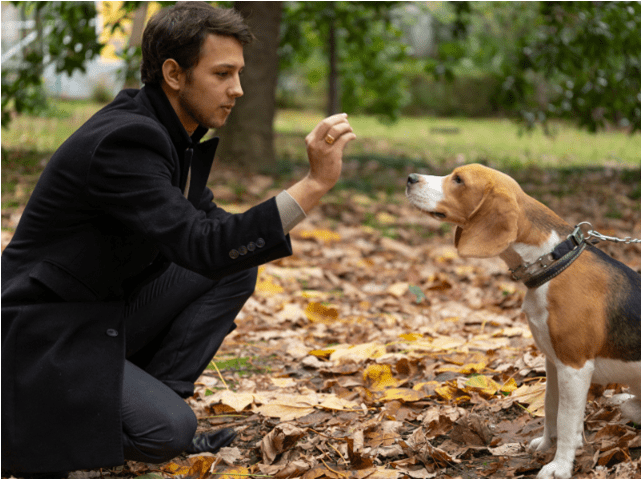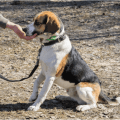Table of Contents
It’s no surprise that a properly trained Beagle will be a much happier, safe and more secure companion that everyone enjoys being around, and that will be far less likely to develop behavior issues later in life.
When your dog respects your leadership and there is no question that YOU are in charge, they can then relax and let you take the lead on training them, which is as it should be. Developing a basic training program and learning to teach your Beagle commands and discipline is all part of starting your dog off on the right paw.
Therefore, this will focus on training basics and tips, including hand signals, as well as simple Beagle tricks that your pet will love to learn.
All of our canine companions are amazing, natural athletes and because of this, no matter their size or breed, they need daily exercise to stay fit and healthy, so that they can be happily well-mannered, and part of their exercise routine includes learning at least three very important training basics, which are “Come – Sit – Stay”.
Every dog will require daily exercise to stay happy and healthy. They will love going for hikes, walks and little adventures with you. Your Beagle may especially enjoy learning routines and fun canine sports with their guardian as well as playing and socializing in a pack of other dogs.
Any type of disciplined exercise you can engage in with your dog will help to exercise both their body and their mind and will burn off pent-up daily energy reserves, so that your dog will be a happy and contented companion that is relaxed and not overweight.
If you find that your Beagle is being a pest by chewing inappropriate items around the home or being demanding of your time, or especially unruly when visitors come to call, this is likely because their mind is not being challenged enough or their body is not being exercised often enough, or long enough each day to drain out their daily pent-up energy reserves.
A healthy, adult Beagle will thrive when being walked several times each day and may also enjoy the challenge of being engaged in other forms of disciplined canine activity, such as Agility or Nose Work.
The loyal, friendly and willing to learn Beagle is a strongly built breed of small companion dog that despite their stubborn streak and stout build is able to excel in many canine sports and bring home those blue ribbons in the sporting, obedience and show arenas.
Use your imagination and find out what canine sports your dog may enjoy learning. So long as you prove to him or her that you mean what you say through firm direction and consistency, rather than too many treats, they will not feel the need to manipulate or question your authority, and will happily follow your direction.
The Beagle can seem to be stubborn, and often this is simply their superior sense of smell distracting them from the situation at hand. They will need fair, firm guidance and discipline from a young age, which includes rules and boundaries, so that they understand you are the boss, and are acutely aware of the line they cannot ever cross, and depending on the particular dog, this should be easily attainable even for a novice guardian.
Even at the young age of eight to ten weeks, most dogs are capable of beginning to learn anything you can teach. If you wait until they are six months old before beginning any serious training program, you could already have a stubborn problem on your hands and a young and strong little dog that may be unwilling to heed your commands.
The backbone of helping to develop a well-balanced and happy Beagle is to provide them with a routine that ensures sufficient time to satisfy their particular physical and mental exercise needs, in combination with additional time to play, sniff, search and explore their world every day.
What you can teach this energetic canine depends entirely upon you and the time and patience you have to devote to their education. No matter what you decide to teach your dog, always train with patience, kindness and positive rewards.
All training sessions should be happy and fun-filled with plenty of food rewards and positive reinforcement, which will ensure that your dog is a happy, attentive student who trusts and respects you as their leader and looks forward to learning new commands, tricks and routines.
Beagle Puppy Training Basics
First, choose a “Discipline Sound” that will be the same for every human family member. This will make it much easier for your Beagle puppy to learn what they can or cannot do and will be very useful when warning or redirecting your puppy before they engage in unwanted behavior.
The best types of sounds are short and sharp, so that you and your family members can quickly say them and so that the sound will immediately get the attention of your puppy, as you want to be able to easily interrupt them when they are about to make a mistake.
It doesn’t really matter what the sound is, so long as it gets your dog’s attention and everyone in the family is consistent. A sound that is really effective in most instances is a simple “UH!” sound that is uttered sharply.
Next, your puppy needs to learn the Three Most Important Words, which are “Come”, “Sit” and “Stay”. These three basic commands will ensure that your puppy remains safe in almost every circumstance.
For instance, when your puppy correctly learns the “Come” command, you can always quickly bring them back to your side if you should see danger approaching. Also, when you teach your puppy the “Sit” and “Stay” commands, you will be further establishing your leadership role, and a puppy that understands that their human guardian is their leader will be a safe and happy follower.
Most puppies are ready to begin training at approximately 10 to 12 weeks of age (and some even earlier), so make your training sessions no more than 5 or 10 minutes (2 or 3 times a day), positive and pleasant with lots of praise and/or treats so that your puppy will be looking forward to their next session.
Come: while most Beagle puppies will be capable of learning commands and tricks at quite a young age, the first and most important command you need to teach your puppy is the recall, or “Come” command.
Begin the “Come” command inside your home. Go into a larger room, such as your living room area. Place your puppy in front of you and attach their leash or a longer line to their Martingale collar, while you back away from them a few feet.
Say the command “Come” in an excited, happy voice and hold your arms open wide. When they come to you, happily praise them and give a treat they really enjoy.
Once your puppy can accomplish a “Come” command almost every time inside your home, you can then graduate them to a nearby park or quiet outside area where you will repeat the process and where there are many more distractions. In order to keep yourself and your Beagle safe, he or she needs to always come to you when asked, despite whatever distractions may be nearby.
Try to choose a time of day when there will be fewer distractions while you are training.
Keep in mind that even after teaching your Beagle the “Come” command, their nose will always take precedence over the commands you are teaching. This means that even when they are really good at the recall command, if an interesting scent distracts them, they may ignore you. Always keep this dog on leash when working in an area where they can easily run off in pursuit of an intriguing scent.
Sit: the “Sit” and “Stay” commands are both easy commands to teach that will help to keep your puppy safe and out of danger in almost every circumstance.
Ask your puppy to “Sit” and if they do not yet understand the command, show them what you mean by gently squeezing with your thumb and middle finger the area across the back that joins with their rear legs.
Do NOT just push them down into a sit, as this can cause damage to their back or joints. When they sit, give them a treat and praise them.
When you say the word “Sit”, at the same time show them the hand signal for this command. While you can use any hand signal, the universal hand signal for “Sit” is right arm (palm open facing upward) parallel to the floor, and then raising your arm while bending at the elbow toward your right shoulder. Once your dog is sitting reliably for you, remove the verbal “Sit” and replace it with the hand signal.
Every time you take your dog out for a walk, which is often a cause of excitement, get into the habit of asking them to sit quietly and patiently at every stage of your walk.
For instance, ask your Beagle to sit and patiently wait while you put on their leash, while you put on your shoes or jacket, after you approach the door, after you are on the other side of the door, while you lock the door, every time you arrive at a street intersection or crosswalk, every time you stop during your walk to speak to a neighbor, greet a friend or admire the view, etc., and do this all in reverse when heading back home.
When you persist with the “Sit” training, it will soon become automatic for your dog to calmly sit every time you stop walking. When you ask your dog to sit for you, they are learning several things all at once; that they must remain calm while paying attention to you, that you are the boss, that they must look to you for direction and that they must respect you as their leader.
Keep in mind that a sitting Beagle puppy is much easier to control than one standing at the alert, ready to bolt out the door or jump on someone. As well, because the action of sitting helps to calm the mind of an excited puppy (or dog), teaching your puppy the “Sit” command is a very important part of their daily interactions with your family members as well as people you may meet when out on a walk.
When you ask your puppy to “Sit” before you interact in any way with them, before you go out, before you feed them, etc., you are helping to quiet their mind, while teaching them to look to you for direction, and at the same time making it more difficult for them to jump, lunge or disappear out a door.
Stay: once your puppy can reliably “Sit”, say the word “Stay” (with authority in your voice) and hold your outstretched arm, palm open toward their head while backing away a few steps. If they try to follow, calmly say “No” and put them back into “Sit”. Give a treat and then say again, “Stay” with the hand signal and back away a few steps.
Practice these three basic “Come”, “Sit”, “Stay” commands everywhere you go, and use the “Sit” command as much as you can to ensure its success rate.
As your puppy gets older, and their attention span increases, you will be able to train for longer periods of time and introduce more complicated routines.
Hand Signals
It’s really important to use the hand signals that go along with the verbal commands during training, so that once your Beagle learns both, you can remove the verbal commands in favor of just hand signals.
Hand signal training is by far the most useful and efficient training method for your Beagle. All too often we inundate our canine companions with a great deal of chatter and noise that they really don’t understand, but because they are so willing to be part of our world, they soon learn the meaning of many words.
Contrary to what some people might think, the first language of a Beagle (or any dog) is a combination of sensing energy and watching body language, which requires no spoken word or sound.
Therefore, when we humans take the time to teach our dog hand signals for all their basic commands, we are communicating with them at a level they instinctively understand, plus we are helping them to become a focused follower, as they must watch us in order to understand what is required of them.
Crate Training
Crate training should be taught to your puppy when he’s around two to three months.
I want you to remember: The crate of your puppy is considered to be his den for safety and security.
Okay, I know that this may come out as a shocker to you since this is often referred to most dog owners as a dreaded place for dogs and puppies alike, and they call it as a “doggie jail.” However, this is not what your puppy sees the crate as.
For the first few times of crate training, your puppy may be upset about being in a crate where his movements are only limited, but after doing crate training frequently, he’ll eventually volunteer to go into the crate by his own accord to take an afternoon nap. Or just to have a break from the household hubbub.
Crate training your beagle helps you with housebreaking, and it allows your puppy to have a secure place for taking a nap or sleeping.
Once your puppy is used to the feeling of being in a crate, traveling with your beagle will become easier. In addition, you can even take him to long trips in the car as well.
Housebreaking
Just like crate training, this is around two to three months.
Two to three months old is still considered as pretty young for puppies, and by at this point, they are still infants. With that being said, these puppies won’t be able to fully control their bladders for a couple of months. In any case, housebreaking happens on the first day you bring your beagle to your home.
On the other side of the spectrum, if you do it entirely wrong, then it’s going to become a really frustrating experience for you.
The problem with owners is that they aren’t aware that there’s something off about their beagle’s accidents. Of course, until it has developed into an undesirable habit. Although it IS possible to do, it won’t be an easy experience.
For the most part, the whole process of housebreaking delivers the emotions of nervousness and worry, but it does not have to be that hard as there are ways where you can make it easier for the both you.
The funny thing is, Mother Nature is already with you from the beginning. On the very first day your puppies were born, they do their business – eating and relieving – inside the comfort of their den. However, mother dog always makes sure to clean them right after.
Meaning, you won’t be able to smell the urine or feces where the newly-born puppies are being placed. As they grow older, they begin to start exploring the outside areas where they try to copy their mom.
Conditioning
You have to condition your beagle as this will teach them not to eliminate in their respective dents. This goes from two to four months of your dog’s age. The good news is that this is quite an easy concept for them to learn (housebreaking and crate training) as this comes naturally to them.
Puppy’s digestive tract
Here’s another factor that makes housebreaking quite easy, and it’s our beagle’s digestive tract. One thing that you should take note is that it’s pretty quick and efficient.
Right after five to thirty minutes of eating, your beagle would want to eliminate. Providing your puppy with a consistent schedule for eating, and keeping your focus on the time, then it would lead to a regular schedule for your puppy to defecate.
An important thing to take note, make sure that during the initial stages of housebreaking, it would be better for your beagle to relieve in an area where she feels secure and safe. In other words, find a place in your home that smells familiar to her.
I’m sure you have noticed this that when a dog eliminates, they would often go to the same area where they did before. The familiar scent lets the dog know that it’s his territory.
Your Energy
This housebreaking process isn’t all about the dog, after all. It includes you as the trainer, and it has a lot to do with how you handle the situation.
To be more precise, it’s your energy that brings the end result of your housebreaking efforts. As you can see, when your emotions are all over the place – nervous or impatient – it can affect your puppy. Yup, it can stress your beagle out.
When you’re too frustrated overtraining your dog, and you use a loud, squeaky voice to tell your dog to eliminate his waste, this is actually a distraction for your beagle. As much as possible, it would be better to avoid saying anything.
Setting A Routine
When you wake up early morning, it would be best to bring your beagle outside to the area where your dog usually eliminate. Keep this routine up consistently, and soon enough, your dog will be able to develop the habit.
Once your beagle has already gone outside, it’s really important to show your dog appreciation by rewarding what he has done right.
Of course, you can always keep the reward simple, and you can do so by giving him a small treat. It’s going to let your dog get the message that he should keep up his good actions.
React Positively
Listen up, there’s no need to push your puppy too hard when an accident happens. Don’t put a negative association just because your dog wasn’t able to control his bodily functions.
All you have to do is to calm your mind, and carefully transfer your beagle to the place where you want him to be.
It’s unavoidable, and you surely have to put more effort into it, especially during the first few weeks of housing your puppy. Don’t forget, this is a very crucial period for your puppy, it’ll dictate his actions in the future.
Housebreaking Rules
I’m pretty sure everyone would agree that every dog owner would want their dog to be housebroken on the first day she arrives in your home. Besides, no one really looks forward to seeing poop or pee in their house when they get home from a long day of work, right?
But there are only TWO things that I want you to know about housebreaking, and these two rules mustn’t be taken lightly.
Confinement
The reason why this is on the list is so that your dog wouldn’t “eliminate” in an area where you don’t want him to.
You have a lot of options to choose from when it comes to confinement, you can place your dog in his crate, a pen, or you can even utilize the use of baby gates so you can make a small section of your space.
Of course, your dog is free to free to explore your home when you’re around him, so it could be when you’re playing with him, taking him for a walk, grooming, and training your beagle. All in all, you should be in the picture, interacting with your dog.
I know that this may be hard for some of you, and letting your dog roam free to run around sounds like a better idea than keeping him in a specific area. But mind you, this isn’t permanent. This encourages him to keep up with his bad habit.
Access
Make sure that your dog has access – whether you choose to give it to your dog on a regular schedule or give complete access to your beagle to the place where you want him to go.
There are things that you can do in this scenario; basically speaking, you have 3 options on the subject. You can take your beagle in your yard once every two to three hours.
You can also install a doggy door in your home so that he’s free to go out for himself into the allocated potty yard you have prepared for your beagle – by the way, this isn’t recommended if you’re going to allow your dog to freely go in and out of your house if you’re not there. He may be continuously braking, which would make your neighbors mad.
And lastly, you can make an indoor bathroom, the materials that you’re going to need are simple household things, like newspapers or a make-shift litter box. If not, he’ll freely do his business wherever your dog pleases.
Tips for Training Beagles
Let’s talk about how you can be a good companion to your beagle. First thing that you need to keep in mind is that beagles are known to be intelligent, active, independent and they this innate impulse of wanting to be in a pack.
As you can already tell, these qualities are quite impressive. However, when you haven’t addressed them accordingly, it could lead to a major problem when it comes to his behavior.
In any case, here are some important things that you should take note of for your Beagle.
Separation Anxiety
Remember when I said Beagles just love to be in a pack – well, they’re the type of breed who wants to be the center of attention for their human squad. As a matter of fact, this exceeds than most of the breeds out there.
If you have work to take care of, and you have to leave your dog for an entire day, then your beagle will most likely get into some sticky situations.
It’s a smart move to make sure that before you leave to go anywhere, you’ve already taken your dog for a brisk walk, a jog around at the local park or even a quick game of Frisbee so that you could use the overabundance of energy that your beagle has.
Digging
Beagles are known to dog for a number of reasons, and this could greatly vary from boredom to hiding their bones into the soil. However, your dog’s motive doesn’t matter because the end result is the same – it’s your yard’s disaster.
On the other hand, if you have a bigger space in your yard, you can even allocate an area where you can place your dog to dig as he pleases. This way, there won’t be any serious damages.
Attention-getting Vocalizations
Another unique trait about beagles is its vocalizations, and this bit is surely unique for your beagle. You may refer it to your beagle’s howl or bark, but there’s one thing I’m sure of, their tone of voice surely is different from the other breeds, and it can be carried on for miles.
Besides, there’s no better way than to catch the attention of hunter to tell them they’ve found their prey. But since the purpose of you getting a beagle is completely different, then you surely won’t find any use of your beagle telling you that there’s a rabbit within the area.
You have to train your beagle when the right time to howl is and when it’s inappropriate to do so. If not, this could really make your neighbors go nuts AND you’ll be able to sleep less peacefully at night.
By doing this, you won’t have to deal with any noise problems anytime soon, and he’ll know when to howl and not to.
Chasing
While it’s true that dogs just LOVE the chase, Beagles are just on a different level. Of course, I don’t have to explain how it all came to be as its origin already speaks for itself.
With that being said, you’ll know by now that Beagles are more “energetic” than other breeds, so you would need it to keep your dog on a leash if you don’t want to start the “chase”.
In addition, if your yard is fenced-in, then it would work in your favor. You’ll be able to keep your sanity, and at the same time, the safety of your beagle will not be compromised.
As a matter of fact, your fence shouldn’t be taller than five feet – or 1.5 meters – tall, this has been stated by National Beagle Club of America. Also, placing a chicken wire or even cement at the foundation of your fence helps, it keeps your beagle in place.
Motivating Your Beagle
If you want your training sessions with your beagle to succeed, then there are some few things that you have to expect from your dog.
Active Temperament
Like, a really active temperament. Being energetic is inborn to them, and although their sense of smell wasn’t as sharp as it was in the origins, they still pretty carry good noses.
The fact that they use their scents as a key for finding where their predators are, this also entails that their focus is locked to only for themselves. So, they don’t really wait for their masters to give them directions.
In most cases, you won’t be using your beagle for the hunt, that’s why training your dog on how to behave in a household is a relatively important task. In order to steer their attention, you would need to exercise your beagle consistently.
Taking The Lead
I’m talking about YOU taking the lead, and not the other way around. Although it’s going to take some time, just remember to be patient as your beagle will eventually learn to trust you.
Here’s the problem, since a beagle has this trait where he sees himself as the leader among the two of you, training him would take you a lot more challenging than training other breeds, such as a Labrador.
For those first-time dog trainers, training your beagle will be ESPECIALLY hard. Your lead should be firm and consistent, and this will make your dog believe in your commands in the long-run.
Training CONSISTENTLY
As an owner of the independent-thinking beagle, you have to train him throughout the day. In other words, you can’t just train your beagle at your designated time for training sessions.
You have to interact with your dog throughout the day by giving a common here and there if you want your beagle to fully learn the basics.
I’ll paint you a picture – normally, you would want your dog to sit or listen to your command before you put the bowl of food down to the floor. So, if your beagle chooses not to listen to you, then don’t do the action.
Put his meal away if he doesn’t do the commands. You have to get your beagle to sit first before you can bring his food bowl out again.
In the situation where he doesn’t sit at the curb before you cross the street with your beagle, then you have to go back a couple of steps, proceed to the designated curb, and ask your beagle to do the action once again,
In a Nutshell
Taking the time to teach your dog basic rules and boundaries, plus simple tricks, will keep them both mentally and physically healthy and happy and you will raise a well-behaved dog that is a joy to be around.
The Beagle has great stamina, and requires more daily exercise than many other breeds. This means that in order to ensure a healthy, happy and contented dog that is not overweight and will not develop behavior issues out of boredom or neglect, you must take the time to involve them in daily vigorous exercise; that can include different activities, such as running or hiking at your side, jogging beside your bicycle or canine sports where they get to use their superior sense of smell.






 Author and long-time animal lover. Sharing knowledge on pet care through experience and the written word.
Author and long-time animal lover. Sharing knowledge on pet care through experience and the written word.